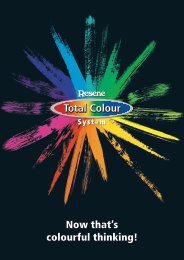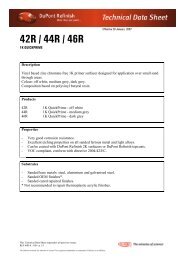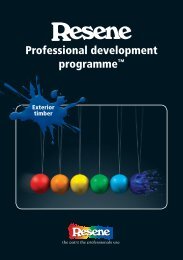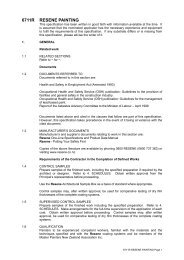Colour Choices - choose colour with creativity and ... - Resene
Colour Choices - choose colour with creativity and ... - Resene
Colour Choices - choose colour with creativity and ... - Resene
Create successful ePaper yourself
Turn your PDF publications into a flip-book with our unique Google optimized e-Paper software.
Science has long recognised that <strong>colour</strong> affects our<br />
behaviour <strong>and</strong> the way we feel. After all, it’s the first<br />
thing we register <strong>and</strong> that we use to help assess the<br />
things around us, such as whether certain foods, such<br />
as blue ones, might be poisonous, for example.<br />
To underst<strong>and</strong> these responses, we need to look at how <strong>colour</strong> works.<br />
Essentially, when the light reflected from <strong>colour</strong>ed objects strikes the<br />
retinas in our eyes, the wavelengths are converted into electrical impulses.<br />
These pass into the part of the brain that rules our hormones <strong>and</strong> endocrine<br />
system, which are instrumental in regulating our moods. Unconsciously,<br />
then, our eyes <strong>and</strong> bodies constantly adapt to these stimuli, influencing<br />
our impulses <strong>and</strong> perceptions.<br />
While the scientific study of <strong>colour</strong> is as old as time, the study of <strong>colour</strong>’s<br />
effects on our psyche is only about a century young.<br />
Even until only about two decades ago, the common perception was that,<br />
because our response to <strong>colour</strong> is subjective, it must also be unpredictable.<br />
Why, for example, did people respond differently to the same shade?<br />
<strong>Colour</strong> personality<br />
It was leading UK <strong>colour</strong> psychologist Angela Wright who, by studying<br />
<strong>colour</strong> harmonies <strong>and</strong> the often unconscious thought processes related<br />
to them, developed a means of predicting our responses to <strong>colour</strong> <strong>with</strong><br />
remarkable accuracy.<br />
It’s called the <strong>Colour</strong> Affects System <strong>and</strong> works on two levels: The<br />
psychological properties of each of the 11 basic <strong>colour</strong>s; <strong>and</strong> the roles<br />
that variations in tones, hues <strong>and</strong> tints can play in achieving a desired<br />
psychological effect. A key factor in this, Angela recognised, is that it is not<br />
one <strong>colour</strong> that triggers our responses, but a combination of the millions<br />
of <strong>colour</strong>s, hues, tones <strong>and</strong> tints the human eye can distinguish. For<br />
example, a grey sky over a summer cornfield will evoke quite a different<br />
emotion than will a grey winter’s sky downtown. Therefore, there are no<br />
wrong <strong>colour</strong>s per se, but different <strong>colour</strong> schemes do prompt different<br />
responses.<br />
To apply <strong>colour</strong> psychology successfully, Angela also recognised the need<br />
to match the individual’s personality <strong>with</strong> the appropriate tonal <strong>colour</strong><br />
family. There are four of these, each reflecting nature’s patterns, <strong>and</strong> every<br />
shade can be categorised into one of them. Once we have made this<br />
connection, she says, we can create <strong>colour</strong> combinations that will help turn<br />
our homes into spaces that reflect <strong>and</strong> support the personalities of those<br />
living there. Even if very different characters live together in one house,<br />
the right <strong>colour</strong> palette can ease tensions <strong>and</strong> help create harmony.<br />
<strong>Resene</strong> Cocktail<br />
41

















